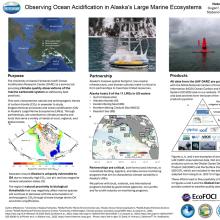Observing Ocean Acidification in Alaska's Large Marine Ecosystems
Natalie
Monacci
University of Alaska Fairbanks
Poster
The surface oceans have absorbed >25% of the total anthropogenic carbon dioxide emissions released into the atmosphere from fossil fuel burning and land-use changes. This gradual absorption of carbon dioxide has increased ocean acidity in a process commonly referred to as ocean acidification. Coastal regions around Alaska are experiencing some of the most rapid onset of ocean acidification events in the global oceans due to naturally high carbon dioxide, increased productivity, and high freshwater input from terrestrial and sea ice sources. The Ocean Acidification Research Center at the University of Alaska Fairbanks is a service laboratory dedicated to observing the intensity, duration, and extent of ocean acidification through observations of the marine carbonate system in Alaska's four large marine ecosystems. Climate quality data sources include discrete seawater samples collected during repeat hydrographic surveys and autonomous sensors deployed on moored platforms and remotely operated vehicles. Long-term time series and sustained monitoring support several converging research efforts including assessing the rate of climate related biogeochemical change, vulnerability of coastal communities, and economic impacts on fisheries. We will highlight instrumentation available for collaborative efforts to assess climate change in coastal waters in the Gulf of Alaska, Bering Sea, Chukchi Sea, and Beaufort Sea.

Poster file
monacci-natalie-poster.pdf
(2.18 MB)
